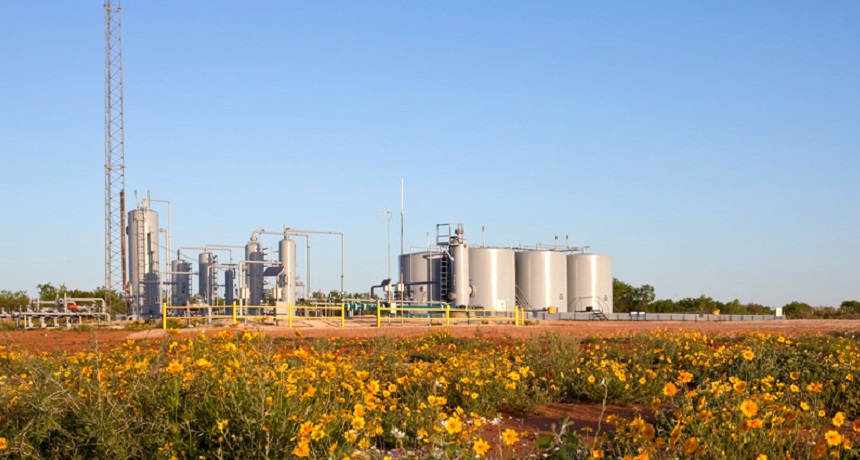Explainer: What is fracking?
Energy companies have found new use for hydraulic fracturing to extract natural gas from shale rock

This is a fracking site, used to bring up natural gas for fuel.
ANGA
By Erica Gies
Fracking is a three-step process. Companies first drill a well, then frack it, then harvest the natural gas, explains David Blackmon. He works for El Paso Corp. It’s a gas company in Houston, Texas.
Here’s what that entails. To create a clean surface on which to work, “We have to level off the ground and pave it with white, chalky caliche [Kuh-lee-chee] rock,” Blackmon notes. Then, the company builds a drill pad. And it’s huge — about 24,000 square meters (about 6 acres) in size.
Next, the company brings in a large rig to drill deep into the ground. This drill rig is typically about 45 meters (150 feet) tall. Because many underground gas deposits are large, a company often drills multiple wells to extract as much gas from that deposit as possible. Drilling the first well takes a couple of months. But once the company understands the characteristics of the local rock, it can drill each new well in a few weeks.
Horizontal drilling allows companies to harvest more gas with fewer wells than in the past. At the Eagle Ford gas field in Texas, workers at El Paso Corp. drill down as much as 3.6 kilometers (almost 12,000 feet). Then they may drill horizontally for another 1.2 to 1.8 kilometers.
Their work zone resembles the construction site for a skyscraper: There are cranes, clanking pipes, throbbing engines. Workers wear steel-toe boots and hardhats for safety. While some people might find the big equipment exciting, many who live near such operations do not like it.
“Even though we’ve had oil and gas development in the United States for some time, it’s now moving into neighborhoods where maybe there wasn’t heavy industry before,” says Nadia Steinzor of Earthworks. It’s based in Washington, D.C.
At a fracking site, companies clear trees and greenery to make way for big equipment. In addition to drilling rigs used to make the well, “You start to have a lot of traffic trucking in water and chemicals for fracking,” she notes. Tanks are installed to separate fracking fluids from the gas as it comes out of the ground. Noisy compressor stations run night and day to squish the gas and send it away through a pipeline. Besides loud noise, the equipment can bring new odors.
All of this activity can radically change the character of a small town.
Blackmon agrees that the work can be loud, particularly the fracking. He says it has “a noise level similar to what you’d hear on an airport runway.” Not surprisingly, workers wear earplugs.
The fracking process itself takes two or three days for each well. “We bring in tanks and big generating engines to power the pumps,” Blackmon explains. On a big frack site on the Eagle Ford gas field, he notes, “we are averaging 4.5 million gallons [or 17,000 cubic meters of water used] per frack.”
After the underground rock is fractured, the gas company installs equipment at the surface to keep the gas contained. This equipment, consisting of a series of valves and pipes, allows the company to collect the gas at a manageable pace.
POWER WORDS
chemical: A substance formed from two or more atoms that unite (bond) in a fixed proportion and structure. For example, water is a chemical made when two hydrogen atoms bond to one oxygen atom. Its chemical formula is H2O. Chemical also can be an adjective to describe properties of materials that are the result of various reactions between different compounds.
development: (in economics and social sciences) The conversion of land from its natural state into another so that it can be used for housing, agriculture, or resource development. (in engineering) The growth or change of something from an idea to a prototype.
engine: A machine designed to convert energy into useful mechanical motion. Sometimes an engine is called a motor. (in computer science) A computer program that performs a particular, narrow range of functions.
environment: The sum of all of the things that exist around some organism or the process and the condition those things create. Environment may refer to the weather and ecosystem in which some animal lives, or, perhaps, the temperature and humidity (or even the placement of things in the vicinity of an item of interest).
extract: (v.) To separate one chemical (or component of something) from a complex mix. (noun) A substance, often in concentrated form, that has been removed from some source material.
fracking: Short for hydraulic fracturing. It’s a process that involves pumping liquid at high pressure underground to crack open rocks, especially to extract natural gas. Those cracks are then held open by sand that had been added to the fracking fluid.
horizontal: A line or plane that runs left to right, much as the horizon appears to do when gazing into the distance.
natural gas: A mix of gases that developed underground over millions of years (often in association with crude oil). Most natural gas starts out as 50 to 90 percent methane, along with small amounts of heavier hydrocarbons, such as propane and butane.
skyscraper: A very tall building.
valve: Something that can reduce or shut off the flow of some gas or liquid through a pipe or other passageway. Some specialized valves may allow a liquid or gas to flow in one direction only.







